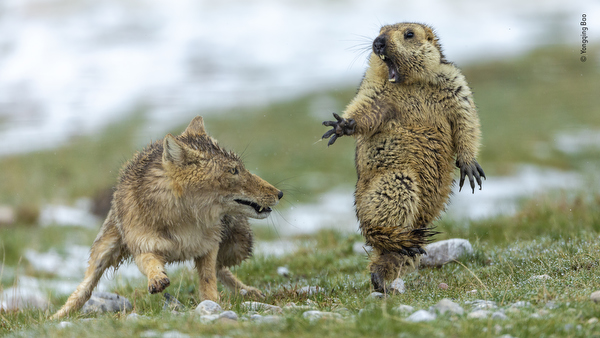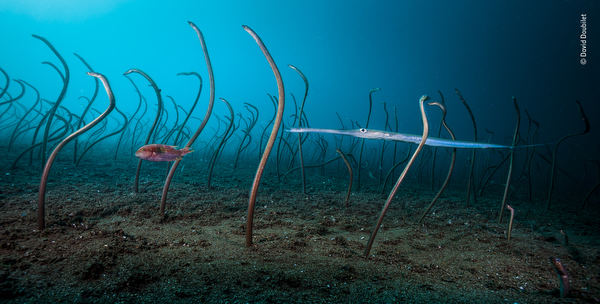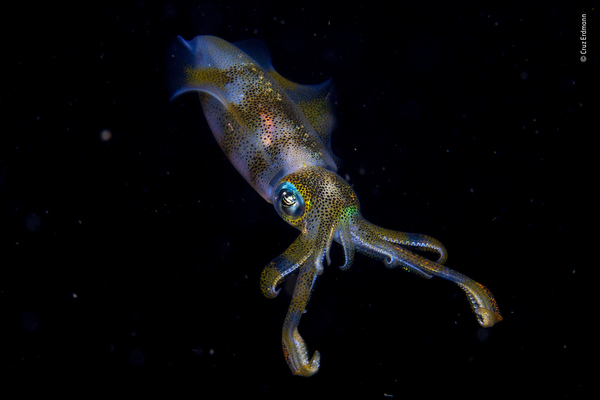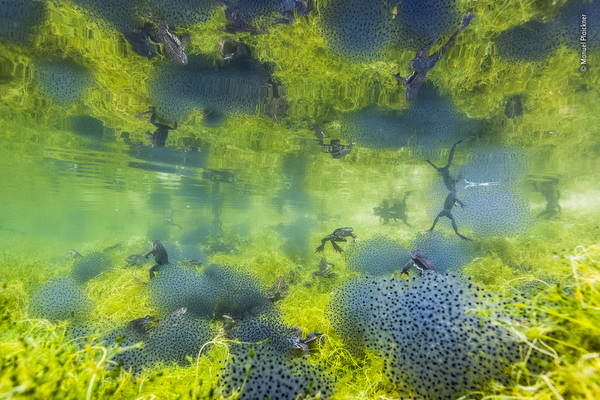Results: Wildlife Photographer of the Year 2019
The results of the 2019 Wildlife Photographer of the Year contest are being announced at a gala event in London’s Natural History Museum tonight. The overall winner was Yongqing Bao with an image of a confrontation between a marmot and an arctic fox. The winner of the Under Water category was David Doubilet, with an image of a garden eel bed in Dauin, Philippines.
As the rest of the Under Water category images are released, we will update this post.

It was early spring on the alpine meadowland of the Qinghai–Tibet Plateau, in China’s Qilian Mountains National Nature Reserve, and very cold. The marmot was hungry. It was still in its winter coat and not long out of its six-month, winter hibernation, spent deep underground with the rest of its colony of 30 or so. It had spotted the fox an hour earlier and sounded the alarm to warn its companions to get back underground. But the fox itself hadn’t reacted and was still in the same position. So the marmot had ventured out of its burrow again to search for plants to graze on. The fox continued to lie still. Then suddenly she rushed forward. And with lightning reactions, Yongqing seized his shot. His fast exposure froze the attack. The intensity of life and death was written on their faces – the predator mid-move, her long canines revealed, and the terrified prey, forepaw outstretched, with long claws adapted for digging, not fighting. Such predator-prey interaction is part of the natural ecology of the plateau ecosystem, where rodents, in particular, the plateau pikas(smaller than marmots), are keystone species. Not only are they the main prey for foxes and nearly all the other predators, they are key to the health of the grassland, digging burrows that also provide homes for many small animals including birds, lizards and insects, and creating microhabitats that increase the diversity of plant species and therefore the richness of the meadows.
Canon EOS-1D X + 800mm f5.6 lens; 1/2500 sec at f5.6 (+0.67 e/v); ISO 640; Manfrotto carbon-fibre tripod + 509HD head.

The colony of garden eels was one of the largest David had ever seen, at least two-thirds the size of a football field, stretching down a steep sandy slope off Dauin, in the Philippines – a cornerstone of the famous Coral Triangle. He rolled off the boat in the shallows and descended along the colony edge, deciding where to set up his kit. He had long awaited this chance, sketching out an ideal portrait of the colony back in his studio and designing an underwater remote system to realize his ambition. It was also a return to a much-loved subject — his first story of very many stories in National Geographic was also on garden eels. These warm-water relatives of conger eels are extremely shy, vanishing into their sandy burrows the moment they sense anything unfamiliar. David placed his camera housing (mounted on a base plate, with a ball head) just within the colony and hid behind the remnants of a shipwreck. From there he could trigger the system remotely via a 12-meter (40-foot) extension cord. It was several hours before the eels dared to rise again to feed on the plankton that drifted by in the current. He gradually perfected the set-up, each time leaving an object where the camera had been so as not to surprise the eels when it reappeared. Several days later – now familiar with the eels’ rhythms and the path of the light – he began to get images he liked. When a small wrasse led a slender cornet fish through the gently swaying forms, he had his shot.
Nikon D3 + 17–35mm f2.8 lens at 19mm; 1/40 sec at f14; ISO 400; Seacam housing; aluminium plate +ballhead; remote trigger; Sea & Sea YS250 strobes (at half power).

Cruz was on an organized night dive in the LembehStrait off North Sulawesi, Indonesia and, as an eager photographer and speedy swimmer, had been asked to hold back from the main group to allow slower swimmers a chance of photography. This was how he found himself over an unpromising sand flat, in just 3metres (10 feet) of water. It was here that he encountered the pair of bigfin reef squid. They were engaged in courtship, involving a glowing, fast‑changing communication of lines, spots, and stripes of varying shades and colors. One immediately jetted away, but the other – probably the male –hovered just long enough for Cruz to capture one instant of its glowing underwater show.
Canon EOS 5D Mark III + 100mm f2.8 lens; 1/125 sec at f29; ISO 200; Ikelite DS161 strobe.

Every spring, for more than a decade, Manuel had followed the mass migration of common frogs in South Tyrol, Italy. Rising spring temperatures stir the frogs to emerge from the sheltered spots where they spent the winter (often under rocks or wood or even buried at the bottom of ponds). They need to breed and head straight for the water, usually to where they themselves were spawned. Mating involves a male grasping his partner, piggyback until she lays eggs – up to 2,000, each in a clear jelly capsule – which he then fertilizes. Manuel needed to find the perfect pond in the right light at just the right time. Though common frogs are widespread across Europe, numbers are thought to be declining and local populations threatened, mainly by habitat degradation (from pollution and drainage) and disease, and in some countries, from hunting. In South Tyrol, there are relatively few ponds where massive numbers of frogs still congregate for spawning, and activity peaks after just a few days. Manuel immersed himself in one of the larger ponds, at the edge of woodland, where several hundred frogs had gathered in clear water. He watched the spawn build up until the moment arrived for the picture he had in mind –soft natural light, lingering frogs, harmonious colors and dreamy reflections. Within a few days, the frogs had gone, and the maturing eggs had risen to the surface.
Canon EOS 5D Mark II + 17–40mm f4 lens at 20mm; 1/640 sec at f8(+0.7 e/v); ISO 800; Seacam housing.